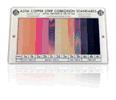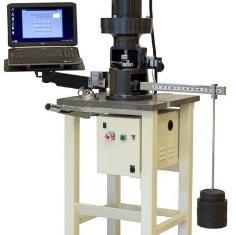Understanding Technical Data Sheets for Grease
Most lubricant suppliers provide a Technical Data Sheet or Sales Brochure that list the typical physical characteristics and typical performance properties of their products. These typical properties provide results to various physical and chemical tests that are performed on the batch of product. A frequently asked question is “What does this result mean? Is it a good value or average?” Reading test results can be confusing. In certain tests, the higher the result, the better the performance. And in others, the lower the result, the better the performance. Let’s review some of the more common physical tests that are conducted on lubricants and grease in particular.
Base Oil Viscosity
Base Oil Viscosity is a critical physical property when working with grease. The correct viscosity is important to provide a suitable oil film and prevent metal to metal contact at normal operating temperatures. When working with grease, a low oil viscosity is used for high speed low load applications to reduce sling off and fluid drag. A high viscosity oil is desired for slower speeds and heavy loads to provide a proper fluid film protection.
Viscosity Index
Viscosity Index is a calculated determination of how much an oil viscosity will vary with temperature change. The higher the number the less the change.
4 Ball Wear Test
4 Ball Wear Test is one test method for predicting wear protection properties.
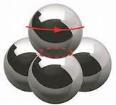
Three balls are locked in place with the lubricant, and the fourth ball is rotated at 1200 rpm under a 40 kg (88 lbs) load at 75°C (167°F) for one hour. The wear scars are then measured under a microscope and an average is reported in millimeters(mm).
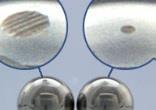
The smaller the number, the better and the greater the wear protection. The test specimens are ½ inch stainless steel balls with a Rockwell hardness of 56-58.
4 Ball Extreme Pressure (EP) Weld Test
4 Ball Extreme Pressure (EP) Weld Test is a standard method for determining the load carrying properties of a lubricant. The test uses the same test specimens as the 4-Ball Wear Test and is performed at room temperature. The top ball is rotated at 1770rpm for 10 seconds under a predetermined load and then the scars are measured under a microscope. The loads are gradually increased until the lubricant film ruptures and the balls physically weld together. The higher the weld load, the more pressure the lubricant can carry without metal to metal contact. The weld load is reported in kg (kilograms) or N (Newtons) and the higher the number, the better in extreme pressure applications. The 10 loads prior to the weld are used to calculate the LWI (Load Wear Index). This relates to how high of a load the lubricant will go prior to the welding without the lubricant film failing. Again, the higher the number, the better.
Water Washout
Water Washout is a dynamic test where 4 grams of grease are packed into a ball bearing, and assembled in the test apparatus. The bearing is rotated at 600 rpm, and water that has been heated to 38°C (100°F) is sprayed on the shielded bearing for one hour. The apparatus is disassembled and allowed to dry and weighed. The amout of grease washed out is calculated and reported as percent loss. The lower the number the better and indicates better water resistance. The test can be run at 79°C (175°F) if requested. Most results are at 38°C (100°F) unless otherwise noted.
Water Spray Off
Water Spray Off is a static test where a known amount of grease is put on a metal plate and water at 100°F (38°C) is sprayed on the grease at 40psi for 5 minutes. The test temperature can vary at customer request. The results are reported as percent loss. The lower the number the better.
Copper Corrosion Test
Copper Corrosion Test a polished copper strip is submersed in a lubricant for 3 hours at 100°C (212°F). The strip is cooled, cleaned, and the tarnish on the test strip is compared to a standard and rated. A “1a” result is slight tarnish and the top rating…. to a “4d” result which is black.
Rust Test
Rust Test a bearing is packed with the test grease, then subjected to 100% humidity for 48 hours. The bearing is dissembled and rated for rust. Normally a “Pass” means no rust occurred. A “0” or a “1” are consider passing. A “1” rating means one spot less than 1 mm is found. The rust test can be run with distilled, salt, or synthetic sea water.
Dropping Point Test
Dropping Point Test determines the temperature at which the thickener melts and drips or the oil separates from the thickener. This test is used to determine the upper operating temperature range of a grease. Relevance is determined by the application. For example, a wheel bearing on vehicle with disc brakes requires a grease with a drop point of 500°F (260°C) or greater.
Oxidation Tests
Oxidation Tests There are several ways to determine the oxidation stability of a lubricant. The Rotating Pressure Vessel Oxidation Test is run at 150°C (302°F) in 100% oxygen and reports the number of minutes until oxygen uptake and pressure loss occurs. ASTM D 943 is run at 95°C (203°F) with water in the presence of a steel and copper catalysist. Samples are taken periodiacally until the acid number passes 2.0 and the number of hours is reported. On both of these tests, the higher the number the better.
The Oxygen Stability Test
The Oxygen Stability Test the lubricant is subjected to 100% oxygen at 100psi at 100°C (212°F) and pressure readings are taken at 100, 500, and 800 hours. The lower the number and the longer the time period the better.
Grease Penetration Test
Grease Penetration Test is the current means for measuring grease viscosity as determined by The National Lubricating Grease Institute (NLGI). The most common grades are the NLGI #2 and the #1. The viscosity range runs from NLGI #6 which is hard to a NLGI #000 which is a fluid grease.
The grease is put into a test cup, then leveled to a smooth surface. The Cone is dropped for 5 seconds and the depth is measured by a micrometer and reported in millimeters of penetration. Unworked Penetration is the viscosity of the grease in the container, sometimes called a 0 Pen.
The Worked Penetration is after the grease has been sheared in the worker for 60 strokes. This is the viscosity the application sees and is used to determine the NLGI grade to use.
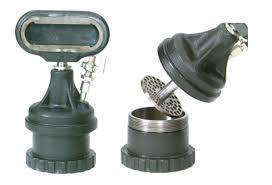
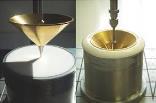
Grease worker.
Extended working of 10,000 up to 100,000 stokes provides information about the stability of the grease to “stay in grade” during long term usage.
Timken Test
Timken Test was originally developed to test cutting oils. It has since been adapted for use with greases and gear oils. This test pushes one pound (454 grams) of grease between a bearing race rotating at 800 rpm and steel block in ten minutes. A load arm holds the weights providing the pressure. A narrow scar less then 1mm with no scoring is a pass and reported as a pass at the number of pounds loaded. For example, “Passes 60 LBs (27kg) Timken” indicates a narrow clean scar carrying a 60 LBs (27 kg) load. This test has fallen out of favor in recent years due to lack of relevance to real world applications.
US Steel Mobility Test
US Steel Mobility Test is used to determine the lowest temperature a grease will pump through a grease gun. A tube is filled with grease, cooled to the test temperature, and pressure applied for 5 minutes. The amount of grease that exits the test apparatus is weighed and the grams (ounces) per minute are reported at the test temperature. Here the higher the number, the easier it is to pump at that temperature.
Lincoln Ventmeter Test
Lincoln Ventmeter Test is designed to determine the lowest temperature a grease would flow through a centralized system. A 25 foot (7.62 meters) coiled copper tube is filled with grease, pressurized to 1800 psi, and cooled to the test temperature. The valve is opened, and the pressure is recorded after 30 seconds. The psi is reported and the lower the number, the better.
NOTE: This is not a complete list of all grease tests but covers most of the commonly used ones. Please contact me if you have any questions.
Source: SWEPCO®


